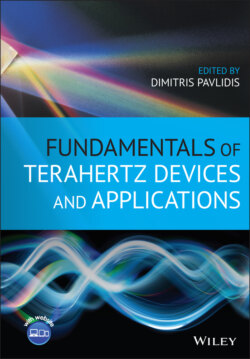Читать книгу Fundamentals of Terahertz Devices and Applications - Группа авторов - Страница 34
Exercises E2.1 Derivation of the Transmission Coefficients and Lens Critical Angle
ОглавлениеIn Section 2.2, we defined the Fresnel reflection coefficients τ⊥(Q), τ∥(Q) as:
(2.69)
(2.70)
where . Similarly, the transmission coefficients can be obtained from the reflection coefficients τ⊥ = 1 + Γ⊥ and . Thus, they are represented as:
Note that the angle of refraction θt increases as the incident angle θi inside of the lens increases (θt > θi). Total internal reflection (Γ = 1) occurs when the angle of refraction is 90° and an incident angle known as the critical angle . After this angle there is no transmission, therefore, this angle defines the domain of the equivalent aperture. As this angle lies at the center distance between the two focuses, the radius of the equivalent aperture is therefore the minor axis b. The incident angle that creates zero reflection in the parallel reflection coefficient is called Brewster's angle. An example of the reflection and transmission coefficients for a lens made in silicon are shown in Figure 2.27a and b, illustrating the critical and Brewster angles.
Figure 2.27 (a) Reflection and (b) transmission coefficient for a silicon lens as a function of the angle. The reflection coefficient becomes 1 for angles larger or equal than the critical angle. The transmission coefficient becomes one for the Brewster angle.
